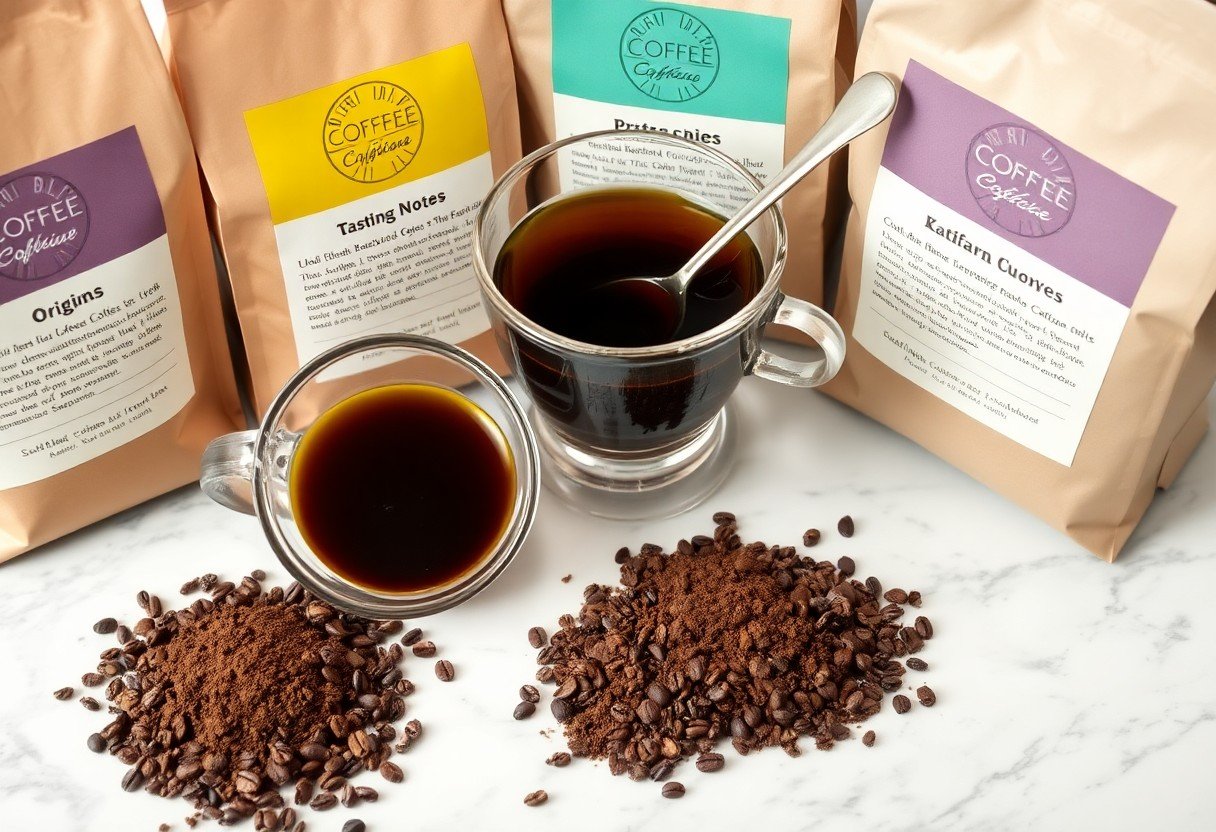Flavor complexity sets artisan coffee apart from everyday brews, offering you a unique tasting experience that reflects careful sourcing and roasting techniques. Your choice of coffee can drastically influence the flavor profile, with artisan beans often selected for their distinct regional characteristics, processing methods, and freshness. By understanding these differences, you can enhance your coffee journey and appreciate the subtleties that elevate artisan coffee above the ordinary.
The Journey from Bean to Brew
Your coffee experience starts far beyond the cup, originating in the farms where coffee beans are cultivated. Each stage of the journey, from harvesting the cherries to roasting the beans, influences the final flavor. Variations in climate, soil conditions, and agricultural practices create distinct characteristics in the beans. Understanding this journey unlocks the complexity of flavors you find in artisan coffee.
The Significance of Coffee Origins
Coffee origins play a pivotal role in shaping flavor profiles. Beans sourced from specific regions, such as Ethiopia or Colombia, exhibit unique characteristics influenced by local climate and soil. For instance, Ethiopian coffees often have floral and fruity notes, while Colombian varieties may present a smoother, nutty flavor. This geographic diversity is fundamental to your appreciation of artisan coffee.
Processing Methods that Impact Flavor
The methods used to process coffee beans can significantly alter their taste. Natural processing, where cherries are dried in the sun, retains more sweetness and fruitiness, while washed processing emphasizes cleanliness and brightness. Each technique reveals different flavor nuances, making you appreciate the craftsmanship behind every cup.
Craftsmanship in Roasting
Artisan coffee roasting is a meticulous process, where attention to detail and quality control are paramount. Roasters often begin with green beans sourced from specific regions, focusing on organic or sustainable practices. They employ small-batch roasting techniques, allowing for greater control over temperature and time to enhance the beans’ inherent flavors. This thoughtful approach contrasts sharply with large-scale industrial roasting, where consistency often supersedes individuality, resulting in a more generic taste profile for the everyday coffee drinker.
Strategies Used by Artisan Roasters
Artisan roasters utilize a variety of strategies that emphasize the unique characteristics of each bean. By controlling factors like temperature, airflow, and roasting duration, they can coax out distinct flavors and aromas that reflect the bean’s origin. Oftentimes, they conduct numerous test roasts to determine the optimal profile for each batch. This exploration includes experimenting with different roasting methods, such as light, medium, or dark roasts, each unlocking different taste dimensions and enhancing the overall coffee experience.
How Roast Profiles Shape Taste
The roast profile you choose significantly influences the flavor attributes of your coffee. Lighter roasts tend to preserve the bean’s natural acidity and bright flavors, showcasing fruity and floral notes. In contrast, medium roasts bring out a balance between acidity and body, often featuring caramel sweetness. Dark roasts, revered for their boldness, can mask the bean’s original flavors, leaning toward rich, smoky, and bitter notes. Recognizing these profiles allows you to select a coffee that aligns with your flavor preferences.
Lighter roast profiles often yield a complex array of flavors, revealing the bean’s origin with clarity and precision. You can taste the nuanced differences that come from various growing conditions, such as altitude and soil composition. Medium roasts offer a harmonious balance, allowing both acidity and sweetness to coexist, while differing roasting lengths influence the body and finish. Dark roasts, although loved for their robustness, may overshadow the unique attributes of the coffee itself, placing focus on deeper, earthy tones and often a longer aftertaste. Understanding these nuances empowers you to explore a broader spectrum of flavors in your coffee journey.

The Art of Brewing
Mastering the art of brewing unveils the depth of flavors that artisan coffee can offer. Low temperatures and precise timing elevate aromatic compounds, while different brew methods can accentuate or mute specific notes. Techniques such as pour-over, French press, and siphon brewing allow you to control variables like water flow and extraction time, creating a unique cup tailored to your palate.
Techniques that Elevate Flavor Extraction
You can optimize flavor extraction by paying attention to grind size, water temperature, and brew time. For instance, a finer grind allows for quicker extraction, ideal for espresso, while coarser grounds benefit longer infusions like cold brew. Experimenting with these parameters can unveil new dimensions in your coffee’s taste profile.
Equipment Choices: Artisan vs. Commercial
Selecting the right equipment impacts your brewing experience significantly. Artisan coffee often utilizes manual methods like pour-over kettles or specialized espresso machines, emphasizing control and precision. In contrast, commercial equipment focuses on efficiency and volume, typically sacrificing some intricacy of flavor for speed and consistency.
Artisan gear often includes brew systems designed for specific techniques, such as Chemex or Aeropress, which allow you to fine-tune every variable. These systems are made from quality materials, enhancing heat retention and reducing unwanted flavor extraction. On the other hand, commercial coffee machines are built for high throughput and may automate processes, which can lead to a more uniform, but less personalized, flavor experience. Choosing equipment that aligns with your brewing style and desired coffee characteristics will ultimately impact the complexity of the flavor profile in your cup.

Tasting Notes: Unpacking Flavor Complexity
Tasting artisan coffee reveals a rich tapestry of flavors that often escape the mundane cup. Each sip offers a unique narrative shaped by factors like bean origin, processing methods, and roasting profiles. As you explore these tasting notes, pay attention to the subtleties; floral undertones, citrus brightness, or chocolatey depths can all emerge, creating a multidimensional experience that stands in stark contrast to everyday coffee. This complexity is a testament to the dedication of artisan producers and the meticulous journey each bean undergoes from farm to cup.
The Role of Aroma and Acidity
Aroma plays a pivotal role in your coffee experience, as it significantly influences flavor perception. The acidity in artisan coffee, often perceived as brightness, enhances the complexity of taste. High-quality beans can exhibit a vibrant acidity that balances sweetness, accentuating flavors like berry or citrus. This interplay of aroma and acidity creates a dynamic tasting experience that transforms a simple cup into a sensory journey.
Understanding the Flavor Wheel
The flavor wheel is an crucial tool for discerning the complexity in artisan coffee. It categorizes flavors and aromas into distinct sections, aiding you in identifying and articulating what you taste. Each segment highlights specific flavor notes, from fruity and floral to earthy and nutty, making it easier to pinpoint the nuances in your cup. Utilizing the flavor wheel not only enhances your appreciation but also improves your ability to communicate your coffee preferences.
Delving into the flavor wheel allows you to navigate coffee’s intricate flavor landscape. By identifying notes like caramel sweetness or herbal undertones, you gain a deeper understanding of what makes each brew unique. This tool is invaluable for both novices and connoisseurs, guiding you to articulate the taste experience and facilitating more enriched discussions around coffee. With practice, you’ll find yourself confidently identifying complex flavors, transforming your coffee-drinking routine into a more intentional and enjoyable ritual.
Consumer Mindsets: Perceptions of Quality
Your perception of coffee quality significantly influences your overall experience. Artisan coffee is often associated with higher standards due to its sourcing, roasting techniques, and craftmanship. This elevated status sets the expectation that it will deliver superior flavor profiles compared to everyday coffee. As you engage with artisan brands, you may find that an appreciation for nuances in taste develops, linked directly to your beliefs about quality and authenticity in the coffee-making process.
The Influence of Price on Taste Expectations
Your expectations for taste are often aligned with the price you pay for coffee. Higher-priced artisan coffees suggest a level of quality and uniqueness that everyday coffee may not provide. You’re likely to approach a $5 cup with a mindset that it should offer complex flavors and unmatched freshness, while a $1 cup may lead you to anticipate a simpler, less engaging experience. This investment in quality significantly alters how you perceive and evaluate the flavors in your cup.
Artisan Branding and its Impact on Flavor Appreciation
The branding of artisan coffee affects your flavor appreciation by emphasizing the story behind each cup. Artisan roasters often highlight specific origins, ethical sourcing, and unique processing methods, which elevate your overall expectation of flavor complexity. As you learn about these narratives, your palate becomes more attuned to the intricacies present in each coffee, enhancing your ability to discern subtle variations in taste.
Artisan coffee branding goes beyond just a label; it cultivates a narrative that resonates with your values and experiences. When you see a brand that champions sustainability, fair trade, or local farmers, you’re not just buying a product; you’re investing in a story. This emotional connection deepens your appreciation for the flavor profiles because you recognize the labor and care that went into each batch. For example, a single-origin coffee from a small farm may strike you differently than a mass-produced blend, as the branding evokes a sense of craftsmanship and authenticity, enhancing your sensory experience of the flavors.
Summing up
Taking this into account, you can appreciate that the differences in artisan coffee flavor profiles stem from the careful selection of beans, unique roasting techniques, and specific brewing methods. These elements work together to create a complex taste experience that everyday coffee often lacks. By exploring artisan options, you can enjoy a diverse range of flavors that reflect the origins of the beans and the craftsmanship of the roaster, elevating your coffee experience beyond the ordinary.
FAQ
Q: What factors contribute to the flavor profiles of artisan coffee?
A: Artisan coffee flavor profiles are influenced by several factors, including the origin of the beans, the roasting process, and the brewing method. Each coffee-growing region imparts distinct tastes due to unique soil, climate, and altitude conditions.
Q: How does the roasting process affect the flavor of artisan coffee?
A: The roasting process brings out different flavors in the beans. Artisan roasters often use lighter roasts to highlight natural flavors and acidity, while traditional coffee may be roasted darker, resulting in a more uniform and often more bitter taste.
Q: Why is the bean origin important in determining flavor profiles?
A: Bean origin plays a significant role as each region yields beans with specific characteristics. For instance, Ethiopian beans are often fruity and floral, while Colombian beans are known for their sweetness and balance, showcasing the diversity in flavor profiles.
Q: How do brewing methods impact the flavor of artisan coffee?
A: Different brewing methods extract flavors in varying ways. Methods like pour-over or French press can highlight distinct notes in artisan coffee, while more automated methods may not fully capture the subtle complexities of the beans.
Q: What role do freshness and storage play in artisan coffee flavor?
A: Freshness is key in artisan coffee, as beans taste best shortly after roasting. Proper storage away from light, moisture, and air helps maintain the flavor integrity, while everyday coffee may lose its peak taste due to longer storage times.

